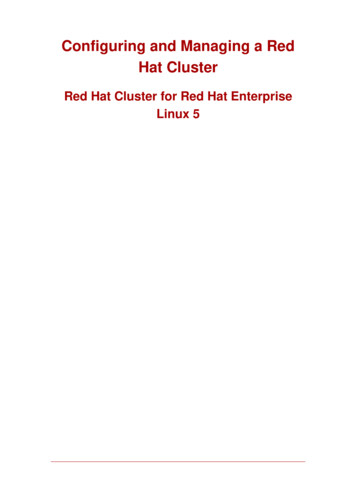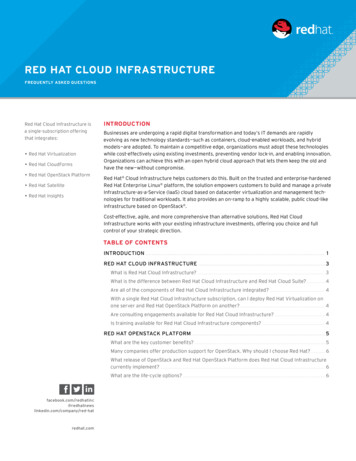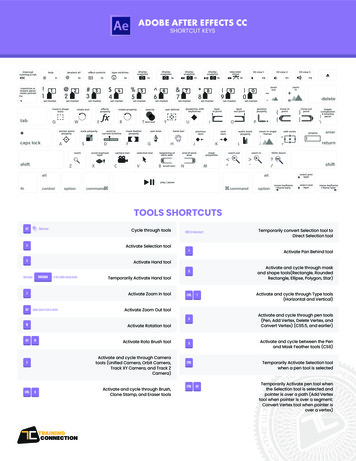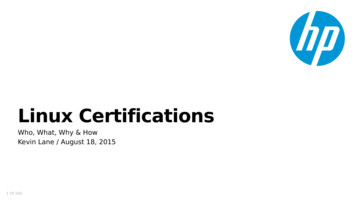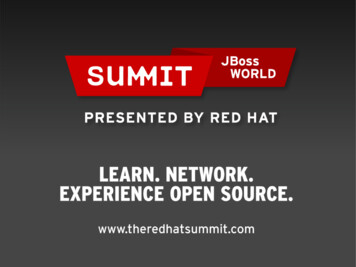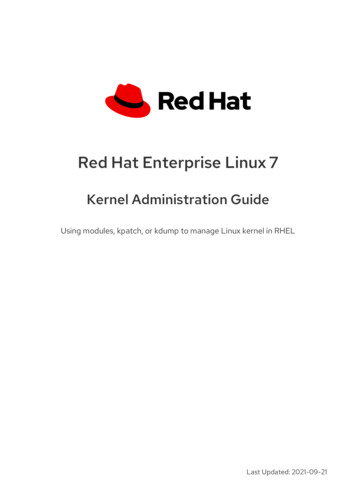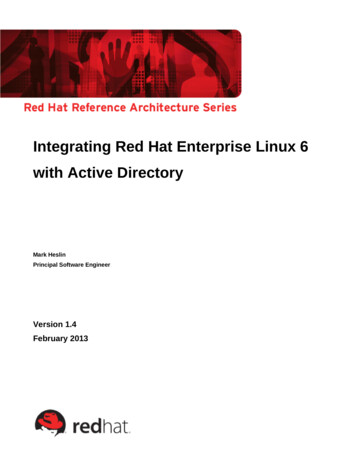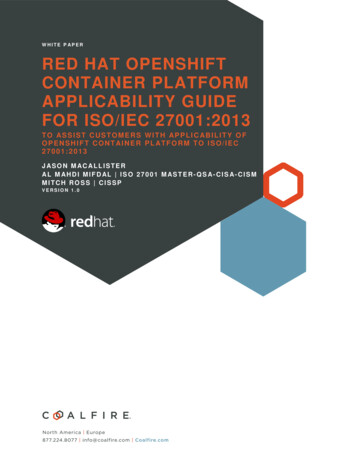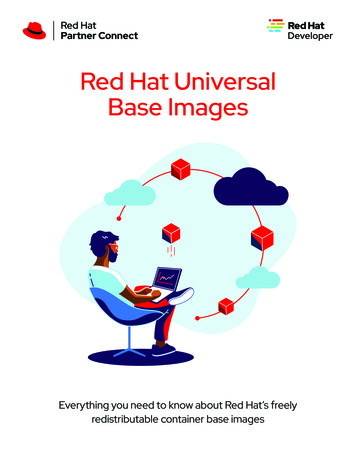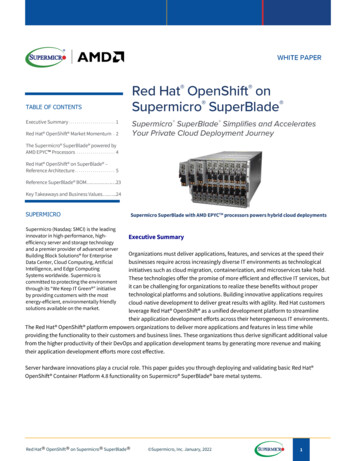
Transcription
TABLE OF CONTENTSExecutive Summary . . . . . . . . . . . . . . . . . . . . . . . 1Red Hat OpenShift Market Momentum . 2The Supermicro SuperBlade powered byAMD EPYC Processors . . . . . . . . . . . . . . . . . . . 4Red Hat OpenShift on SuperBlade –Reference Architecture . . . . . . . . . . . . . . . . . . . . 5Reference SuperBlade BOM 23Key Takeaways and Business Values . .24SUPERMICROSupermicro (Nasdaq: SMCI) is the leadinginnovator in high-performance, highefficiency server and storage technologyand a premier provider of advanced serverBuilding Block Solutions for EnterpriseData Center, Cloud Computing, ArtificialIntelligence, and Edge ComputingSystems worldwide. Supermicro iscommitted to protecting the environmentthrough its “We Keep IT Green ” initiativeby providing customers with the mostenergy-efficient, environmentally friendlysolutions available on the market.Supermicro SuperBlade with AMD EPYCTM processors powers hybrid cloud deploymentsExecutive SummaryOrganizations must deliver applications, features, and services at the speed theirbusinesses require across increasingly diverse IT environments as technologicalinitiatives such as cloud migration, containerization, and microservices take hold.These technologies offer the promise of more efficient and effective IT services, butit can be challenging for organizations to realize these benefits without propertechnological platforms and solutions. Building innovative applications requirescloud-native development to deliver great results with agility. Red Hat customersleverage Red Hat OpenShift as a unified development platform to streamlinetheir application development efforts across their heterogeneous IT environments.The Red Hat OpenShift platform empowers organizations to deliver more applications and features in less time whileproviding the functionality to their customers and business lines. These organizations thus derive significant additional valuefrom the higher productivity of their DevOps and application development teams by generating more revenue and makingtheir application development efforts more cost effective.Server hardware innovations play a crucial role. This paper guides you through deploying and validating basic Red Hat OpenShift Container Platform 4.8 functionality on Supermicro SuperBlade bare metal systems.Red Hat OpenShift on Supermicro SuperBlade Supermicro, Inc. January, 20221
Red Hat OpenShift Market Momentum:Red Hat OpenShift Container Platform (OCP) provides enterprise Kubernetes bundled CI/CD pipelines. It automates builds anddeployments, enabling developers to focus on application logic while leveraging best-of-class enterprise infrastructure.Forrester reports that the Red Hat OpenShift Container Platform leads the growing enterprise App Container market.Figure 1: The Forrester WaveForrester 1 says that "Red Hat OpenShift is the most widely deployed multi-cloud container platform and boasts powerfuldevelopment and unified operations experiences across many public and on-premises platforms. Red Hat pioneered the‘operator’ model for infrastructure and application management and provides a rich partner ecosystem and popularmarketplace."1 - The Forrester Wave : Multicloud Container Development Platforms, Q3 2020: The Eight Providers That Matter Most and How They Stack Up Sep 2020Red Hat OpenShift on Supermicro SuperBlade Supermicro, Inc. January, 20222
Applications are the competitive differentiator in today’s market. Deploying cloud-native applications represents anopportunity to build recurring revenues, highmargin services, and platform renewals.According to Gartner 2, “By 2025, more than85% of global organizations will be runningcontainerized applications, a significantincrease from fewer than 35% in 2019.”Red Hat OpenShift Container PlatformRed Hat OpenShift Container Platform is an open-source container application platform built primarily on Docker containersand orchestrated using Kubernetes container cluster Red Hat OpenShift management. Red Hat OpenShift supports a broadrange of programming languages and services ranging from web frameworks, databases, or connectors to mobile devices andexternal back ends. The Red Hat OpenShift platform supports both cloud-native, stateless applications and traditional,stateful applications.The primary IT initiatives that Red Hat OpenShift targets are: Accelerating application delivery with agile and DevOps methodologies: Red Hat OpenShift offers a commonplatform for development and operations teams to ensure consistency and standardization of applicationcomponents, eliminate configuration errors, automate deployment, and enable a controlled rollout of newcapabilities into production and rollback in the event of a failure. Additional capabilities enforce policies and rolebased access control for environments with elevated security and regulatory requirements. Modernizing application architectures toward microservices: Red Hat OpenShift provides a common platform forcloud-native microservices applications alongside existing traditional stateful applications. A broad choice ofapplication frameworks, programming languages, and developer tools empowers customers to prototype innovativeapplications more quickly. Red Hat OpenShift also allows access to a broad range of Red Hat and third-party services,application and middleware services, API management, and storage services. Adopting a consistent application platform for hybrid cloud deployments: IT organizations that want to decoupleapplication dependencies from the underlying infrastructure adopt container technology to migrate and deployapplications across multiple cloud environments and data centers. Red Hat OpenShift provides a consistentapplication development and deployment platform regardless of the underlying infrastructure. It also providesoperations teams with a scalable, secure, and enterprise-grade application platform and unified container and cloudmanagement capabilities.Red Hat OpenShift is commonly delivered as either: Red Hat OpenShift Container Platform for enterprise customers that want to deploy and manage Red Hat OpenShiftin their own datacenter or at a public cloud provider. As a cloud-based service.2 - Gartner Infrastructure, Operations, and Cloud Summit 2020Red Hat OpenShift on Supermicro SuperBlade Supermicro, Inc. January, 20223
The Supermicro SuperBlade powered by AMD EPYC ProcessorsSUPERMICRO AMD SUPERBLADE8U SuperBlade Server System EnclosureSBE-820H/C/J/L-822/622/422Supermicro SuperBlade is built for the most demanding workloads that requirehigh CPU density and the fastest networking available today. Supermicro's newgeneration blade portfolio is designed to optimize the TCO of key components fortoday's datacenters, such as cooling, power efficiency, node density, andnetworking management. In addition, the Supermicro SuperBlade powered by 3rdGen AMD EPYC Processors is a trusted platform that meets enterprise customerdemands for on-premises private/hybrid cloud deployments.The Supermicro SuperBlade comes in an 8U chassis, accommodates up to 20 hotpluggable single socket nodes, and delivers high performance with AMD EPYC Processors and DDR4 3200MHz memory, and fast I/O with PCIe Gen4. There are 3AMD powered SuperBlade models available, a SAS model, a SATA model, and a GPUaccelerated model, all of which can be mixed in a single 8U enclosure. The 8USuperBlade can support up to 40 single width GPUs or 20 double width GPUs.SuperBlade SAS/SATA models support AIOM for front I/O, which extends the OpenCompute Project 3.0 specification to support a wide range of networking options ina small size form factor. The 8U SuperBlade also provides customers with advancednetworking options, such as 200G HDR InfiniBand or 25G Ethernet switches.The Supermicro SuperBlade offers the significant advantage of sharing cooling andpower between the server blades to reduce power consumption compared toindividual rackmount servers that contain their own non-sharable fans and powersupplies. Supermicro is also committed to protecting the environment through our“We Keep IT Green ” initiative that provides customers with the most energyefficient, environmentally-friendly solutions available on the market.SBA-4114S-C2NAIOM for Front I/OSBA-4119SGGPU /PCIe CardsEach SuperBlade enclosure contains at least one Chassis Management Module(CMM). The CMM allows administrators to remotely manage and monitor serverblades, power supplies, cooling fans, and networking switches. SuperCloudComposer (SCC) is a composable cloud management platform that provides aunified dashboard to administer software-defined data centers. SCC canorchestrate cloud workloads via the streamlined industry-standard Redfish API.SCC can also monitor and manage a broad portfolio of multi-generationSupermicro servers from a single pane of glass, including SuperBlade.The new 3rd Gen AMD EPYC 7003 Series Processors are built around the "Zen3" corethat delivers up to 19% more instructions per cycle than previous generations andcontains up to 64 cores per socket for industry-leading performance on popularbenchmarks and real-world workloads. As a result, Supermicro and AMD have setmultiple world records for performance. 3Supermicro's high performance, densityoptimized, and perBlade can significantlyreduceinitialby 3 Gen AMD EPYC processors includes a range of compute systems designed formanythemost ons: Artificial Intelligence (AI), Machine Learning (ML), High Performance Computing(HPC), enterprise applications, and cloud deployments. These systems help organizations reduce time-to-solution for a wide3 - dsRed Hat OpenShift on Supermicro SuperBlade Supermicro, Inc. January, 20224
range of applications, add advanced security features, and allow all workloads to run either on-prem or in a public or privatecloud. The Supermicro SuperBlade offers the highest density, maximum performance, best power efficiency, and lowest TotalCost of Ownership (TCO).Supermicro and Red HatSupermicro and Red Hat are working together to offer proven, validated solutions and reference architectures across multipleRed Hat software platforms, including Red Hat OpenShift. This collaboration involves careful engineering and testing thatremoves much of the time, risk, and time required to deploy modern hybrid cloud infrastructure, allowing organizations tofocus on their applications.Red Hat OpenShift on SuperBlade – Reference ArchitectureCustomers requiring a bare metal on-premise container platform solution can use the new Red Hat feature-assisted installeravailable from https://cloud.redhat.com/openshift/install/metal.A fully-populated 20-node SuperBlade in an 8U Chassis can be configured as: 1 admin/provisioner node for the Red Hat OpenShift cluster. 3 Red Hat OpenShift master nodes to manage the Kubernetes cluster and schedule pods to run on worker nodes. 4 Red Hat OpenShift container-native storage nodes to provide containers with persistent storage. 8 Red Hat OpenShift worker nodes to host the application pods. 3 Red Hat OpenShift infrastructure nodes to run routing services, the container application registry. 1 load balancer node.Red Hat OpenShift on Supermicro SuperBlade Supermicro, Inc. January, 20225
1 admin node,3 Master Nodes(Manage K8S Cluster, schedulepods to run on worker nodes) 8 Worker Nodes (host the applicationpods)3 Infra Nodes (routing, registry)1 Load Balancer (HAProxy)4 Container NativeStorage NodesPersistentVolumesFigure 2: Deploying Red Hat OpenShift Container Platform on Supermicro SuperBladeInstallation OverviewThe assisted installer focuses on bare-metal deployments and helps simplify Red Hat OpenShift Container Platform (OCP)installation. The service discovers and validates targeted hardware and significantly improves installation success rates. Thissection guides you through installing the Red Hat SaaS portal to deploy an OCP cluster using Supermicro SuperBlade ascontrol plane nodes for compute/storage resources. The benefits of containerization include: Highly available control plane nodes via affinity rules. Resource consolidation for physical hosts. Simplified backup and restore.Note: A fully-populated Supermicro SuperBlade can accommodate 20 nodes; however, this white paper uses seven nodes fortesting this deployment.The prerequisites for deploying OCP are:1.Shared VLAN: The assisted installer requires all nodes to be present on the same VLAN to use a virtual IP address forboth ingress and API.2.DHCP: The shared VLAN requires DHCP, much like an Installer-Provisioned Installation (IPI).3.DNS: The cluster requires DNS records for ingress and API access. The assisted installer supports creating theserecords for the user via route53, but in this white paper, the following DNS records have been created.Red Hat OpenShift on Supermicro SuperBlade Supermicro, Inc. January, 20226
File: Sample DNSMASQ (/etc/dnsmasq.d) Configuration file used in this white paperDnsmasq is a lightweight, easy to configure, DNS forwarder, and DHCP server. It is designed to provide DNS and,optionally, DHCP to a small network.# DHCP and Forward & Reverse DNS configuration# /etc/dnsmasq.d/domain name.conf# Don't use /etc/resolv.confno-resolvinterface baremetal#interface lolisten-address Enter Listen IP addr here bind-interfaces# Don't use /etc/hostsno-hosts# Recursive DNSserver Enter server IP addr here # Set local domaindomain Enter domain name here #### DHCP (dnsmasq --help dhcp)dhcp-range Enter start IP addr, end IP addr here #set DHCP optionsdhcp-option Enter option:netmask,subnet netmask 24 here dhcp-option Enter option:router,router IP addr here dhcp-option Enter option:dns-server,dns-server IP addr here # External API endpoint (External API VIP)address Enter /api.domain name/endpoint IP addr here # Internal API endpoint (Internal API VIP)address Enter /api-int.domain name/endpoint IP addr here # wildcard domain *.apps. clusterName . baseDomain (Ingres VIP)address Enter /.apps.domain name/ingres IP addr here # master0 / etcd-0dhcp-host Enter master0 MAC addr,master0 IP addr,master-0.domain name here address Enter /master-0.domain name/master0 IP addr here ptr-record Enter master0 ptr-record IP addr.in-addr.arpa,master-0.domain namehere # master1 / etcd-1dhcp-host Enter master1 MAC addr,master1 IP addr,master-1.domain name here address Enter /master-1.domain name/master1 IP addr here ptr-record Enter master1 ptr-record IP addr.in-addr.arpa,master-1.domain namehere # master2 / etcd-2dhcp-host Enter master2 MAC addr,master2 IP addr,master-2.domain name here address Enter /master-2.domain name/master2 IP addr here ptr-record master2 ptr-record IP addr.in-addr.arpa,master-2.domain name here Red Hat OpenShift on Supermicro SuperBlade Supermicro, Inc. January, 20227
# worker1dhcp-host Enter worker1 MAC addr,worker1 IP addr,worker-1.domain name here address Enter /worker-1.domain name/worker1 IP addr here ptr-record Enter worker1 ptr-record IP addr.in-addr.arpa,worker-1.domain namehere # worker2dhcp-host Enter worker2 MAC addr,worker2 IP addr,worker-2.domain name here address Enter /worker-2.domain name/worker2 IP addr here ptr-record Enter worker2 ptr-record IP addr.in-addr.arpa,worker-2.domain namehere # worker3dhcp-host Enter worker3 MAC addr,worker3 IP addr,worker-3.domain name here address Enter /worker-3.domain name/worker3 IP addr here ptr-record Enter worker3 ptr-record IP addr.in-addr.arpa,worker-3.domain namehere ## END OF FILENode Requirements CPU architecture: All nodes must use x86 64 CPU architecture. Identical nodes: Red Hat recommends that all nodes in a single cluster share an identical configuration (brand,model, CPU, RAM, and storage). Baseboard Management Controller access: The provisioner node must be able to access the BaseboardManagement Controller (BMC) of each OCP cluster node using either IPMI, Redfish, or a proprietary protocol. Latest generation: IPI relies on BMC protocols that must be compatible across nodes. All nodes must be recentenough to support RHEL 8 for the provisioner node and RHCOS 8 for the control plane and worker nodes.Additionally, RHEL 8 ships with the most recent RAID controller drivers. Registry node: (Optional) If you are setting up a disconnected mirrored registry, then Red Hat recommends havingthe registry reside in its own node. Provisioner node: IPI requires one provisioner node. Control plane: IPI requires three control plane nodes for high availability. Worker nodes: While not required, a typical production cluster has one or more worker nodes. Smaller clusters aremore resource-efficient for administrators and developers during development, production, and testing. Network interfaces: Each node must have at least one 10 Gigabit Ethernet (GbE) network interface for theroutable bare metal network. By default, each node must also have one 10GbE network interface forRed Hat OpenShift on Supermicro SuperBlade Supermicro, Inc. January, 20228
a provisioning network when using the provisioning network for deployment. Network interface names must followthe same naming convention across all nodes. For example, the first NIC name on a node, such as eth0 or eno1,must be the same name on all the other nodes. The same principle applies to the remaining NICs on each node. Unified Extensible Firmware Interface (UEFI): Installer-provisioned installation requires UEFI boot on all OCPnodes when using IPv6 addressing on the provisioning network. UEFI Device PXE settings must also be set to use theIPv6 protocol on the provisioning network NIC. (Omitting the provisioning network removes this requirement.)One of the master nodes will be used to bootstrap the cluster and then converted into another master node. Both thekubeconfig and a link to the cluster console will be available for download once the cluster installation is complete.Configure the node BIOS settings for the virtual CD mount and enable virtualization for the hyper-converged nodes. Next,configure the nodes by assigning a hostname and an IP address along with the desired IPMI user name and password, asshown below.Blade #HostnameIPMI IPIPMI UserIPMI 6SMCISMCISMCISuper123Super123Super123Red Hat OpenShift on Supermicro SuperBlade Supermicro, Inc. January, 20229
Step 1Set Boot ModeSelect to UEFI.Step 2Set Boot Option#1 to the correctUEFI boot disk.Red Hat OpenShift on Supermicro SuperBlade Supermicro, Inc. January, 202210
Step 3Set SVM Mode toEnabled to enableCPU virtualization.Step 4Set SR-IOVSupport toEnabled.Red Hat OpenShift on Supermicro SuperBlade Supermicro, Inc. January, 202211
Step 5Set IOMMU toEnabled.Step 6Set PCI AERSupport toEnabled.Step 7Download theSupermicro IPMItool toSMCIPMITool is an out-of-band Supermicro utility that allows users to interface with SuperBladesystems and IPMI devices via the Command Line Interface (CLI). It is available t Free.aspx?cat IPMIRed Hat OpenShift on Supermicro SuperBlade Supermicro, Inc. January, 202212
mount/unmountUSB virtual mediaand System PowerControl.Step 8Log in tothe portal usingyour Red Hatcredentials. Thiswill auto-populateany pull secretsrequired to pullcontainer imagesassociated withthe account. Oncelogged in, click theCreate Clusterbutton to start thenew OCPinstallation.Red Hat OpenShift on Supermicro SuperBlade Supermicro, Inc. January, 202213
Enter the desiredcluster name andthe version of RedHat OpenShift tobe deployed.This example usesldc2-sanjose asthe cluster name.Click Next tocontinue.Step 9Click theGenerateDiscovery ISObutton.Red Hat OpenShift on Supermicro SuperBlade Supermicro, Inc. January, 202214
Step 10Provide the SSHpublic key of theadmin/provisionernode from whereyou can managethe cluster.Click theGenerateDiscovery ISObutton.Step 11Download theDiscovery ISO to aSamba file shareor webserver fromwhere you canmount the imageusing theSupermicrocommand linetools.Step 12Unmount anyexisting virtualmedia from allcontrol andcompute nodesStep 13Mount thedownloaded RedHat OpenShiftfor i in {1.6};do ./SMCIPMITool 172.17.41.8 i SMCI Super123 wsiso umount;donefor i in {1.6};do ./SMCIPMITool 172.17.41.8 i SMCI Super123 wsiso mount/share/discovery image ldc2-sanjose.iso;doneRed Hat OpenShift on Supermicro SuperBlade Supermicro, Inc. January, 2022172.17.41.115
install virtualmedia, which canbe either an SMBshare or http URLfor thedownloaded ISO.This example usesan SMB share.Step 14Set the one-timebootable device tothe virtual USBmedia as in Step7.for i in {1.6};do ./SMCIPMITool 172.17.41.8 i SMCI Super123 ipmi power bootoption 13;doneStep 15Check the powerstatus of allmaster andworker nodes.for i in {1.6};do ./SMCIPMITool 172.17.41.8 i SMCI Super123 ipmi power status;doneReset or turn onthe power tomount the onetime virtual USBmedia which wasset in step 13,for i in {1.5};do ./SMCIPMITool 172.17.41.8 i SMCI Super123 ipmi power reset;doneOrfor i in {1.5};do ./SMCIPMITool 172.17.41.8 i SMCI Super123 ipmi power up;doneStep 16The inventoryshould look likethis once theservers boot withthe discoveryimage and theinventory isfinished.Red Hat OpenShift on Supermicro SuperBlade Supermicro, Inc. January, 202216
Step 17Assign theappropriate rolesand hostnamesfor the systems.Check the InstallOpenShiftVirtualizationand InstallOpenShiftContainerStoragecheckboxes forthehyperconvergedworker nodes.Step 18Either add the APIand ingress VIPsor allow DCHPassignment.This example usessoftware-definednetworking.Red Hat OpenShift on Supermicro SuperBlade Supermicro, Inc. January, 202217
Step 19Click the InstallCluster button tobegin the baremetal/VM clusterinstallation.Step 20One of themasters will beused to bootstrapthe cluster thenconverted intoanother masternode.The kubeconfigand a link to thecluster consolewill be availablefor downloadonce the clusterinstallationcompletes.Step 21Once theinstallation iscomplete, you canlog in to theconsole with theprovided DNSentries and thekubeadminpassword.Download thekubeconfig file forthe OCP CLI tools.Red Hat OpenShift on Supermicro SuperBlade Supermicro, Inc. January, 202218
Step 22Add the DNSentries to yourexternal DNS(preferred) orlocalhost file.(Local /etc/hosts)Step 23Launch the OCPconsole byclicking the“LaunchOpenShiftConsole” in theabove step 21 andlogin with thekubeadmin and itspasswordsrecorded in Step20.Red Hat OpenShift on Supermicro SuperBlade Supermicro, Inc. January, 202219
Step 24Access the OCPNodes screen.Step 25Export thedownloadedkubeconfig file torun the OCPcommands.Step 26Get the Red HatOpenShift nodesstatus.Step 27Get the installedRed Hat OpenShiftversion.export KUBECONFIG /home/kni/kubeconfig[kni@provisioner ] oc get er38m[kni@provisioner ] oc versionClient Version: 4.8.4Server Version: 4.8.2Red Hat OpenShift on Supermicro SuperBlade VERSIONv1.21.1 051ac4fv1.21.1 051ac4fv1.21.1 051ac4fv1.21.1 051ac4fv1.21.1 051ac4fv1.21.1 051ac4f Supermicro, Inc. January, 202220
Figure 3: Topology diagram – Red Hat OpenShift admin, master, and worker node deployment on Supermicro SuperBladeRed Hat OpenShift on Supermicro SuperBlade Supermicro, Inc. January, 202221
Figure 4: Red Hat OpenShift control plane nodesThe installer automatically destroys the bootstrap VM and moves the virtual IP addresses (VIPs) to the control plane nodeswhen the Red Hat OpenShift control plane node installation is complete and fully operational.Figure 5: Red Hat OpenShift control plane nodes fully operationalRed Hat OpenShift on Supermicro SuperBlade Supermicro, Inc. January, 202222
Reference SuperBlade BOMThe Bill of Materials (BOM) used for the Red Hat OpenShift Container Platform installation described in this white paperincludes:ADMIN NODE(x1)Part TypeSystemSBA-4114S-C2NProcessorMemoryInternal Storage(for OperatingSystem)Internal Storage(for Data)PSE-MLN7543P-001MEM-DR416L-SL02-ER32Part DescriptionSupermicro SuperBlade (AMD Powered SingleSocket SAS model)3rd Gen AMD EPYC 7003 Series Processor(7543P - 32 Cores, 2.8GHz, 225W TDP)16GB DDR4-3200HDS-IMN0-SSDPELKX020T82 TB M.2 NVMe SSDPart TypeSystemProcessorMemoryInternal Storage(for OperatingSystem)Internal Storage(for Data)Part TypeSystemProcessorMemoryInternal Storage(for OperatingSystem)Internal Storage(for OperatingData)Part #HDS-IUN2-SSDPE2KX020T82 TB U.2 NVMe SSDMASTER NODES(x3)Part #Part DescriptionSupermicro SuperBlade (AMD Powered SingleSBA-4114S-C2NSocket SAS model)3rd Gen AMD EPYC 7003 Series ProcessorPSE-MLN7543P-001(7543P - 32 Cores, 2.8GHz, 225W TDP)MEM-DR432L-SL02-ER3232GB DDR4-3200HDS-IMN0-SSDPELKX020T82 TB M.2 NVMe SSDHDS-IUN2-SSDPE2KX020T82 TB U.2 NVMe SSDWORKER NODES(x3)Part #Part DescriptionSupermicro SuperBlade (AMD Powered SingleSBA-4114S-C2NSocket SAS model)3rd Gen AMD EPYC 7003 Series ProcessorPSE-MLN7763-0312(7763 – 64 Cores, 2.45GHz, 280W TDP)MEM-DR464L-SL01-ER3264GB 0T82 TB M.2 NVMe SSD2HDS-IUN2-SSDPE2KX020T82 TB U.2 NVMe SSD2Red Hat OpenShift on Supermicro SuperBlade Supermicro, Inc. January, 202223
Key Takeaways and Business ValuesRed Hat OpenShift Container Platform provides enterpriseKubernetes bundled CI/CD pipelines, automated builds, anddeployments that allow developers to focus on applicationlogic while leveraging all best-of-class enterpriseinfrastructure.Deploying Red Hat OpenShift on Supermicro SuperBlade gives organizations a consistent application developmentand deployment platform. Operations teams benefit fromthe scalable, secure, enterprise-grade application platformwith unified container and cloud management capabilities.This validated reference architecture allows customers toefficiently design, deploy, and operate a containerizedDevOps/PaaS platform.Supermicro SuperBlade powered by 3rd Gen AMD EPYC 7003Series Processors allows Kubernetes to be run in productionenvironments with the operational efficiency andconsistency needed to meet various SLAs and IT initiatives. Itenables increased productivity, reduced total cost ofownership, and scalability into your datacenter.Red Hat OpenShift on Supermicro SuperBlade SUPERMICRO SUPERBLADE PROVIDES BUSINESSVALUES TO ENTERPRISE CUSTOMERSBetter performance per watt and per dollarSuperBlade offers: Maximum performance and highest density at lowestcost. Cost benefits from reduced cabling, shared power andcooling efficiencies, and front serviceability.Faster, better performance on cloud workloadsSuperBlade offers better performance with: High-core-count 3rd Gen AMD EPYC processors. Unmatched network performance with 10/25/100 GbEnetwork switch connectivity. High bandwidth and low latency with 100/200 GInfiniBand.Greener environmental impact and lower TCO Maximum power optimization using titanium-levelpower supplies with 96% efficiency. Modular upgrades that reduce e-waste. Supermicro, Inc. January, 202224
Red Hat OpenShift on Supermicro SuperBlade Supermicro, Inc. January, 2022 5 range of applications, add advanced security features, and allow all workloads to run either on-prem or in a public or private cloud. The Supermicro SuperBlade offers the highest density, maximum performance, best power efficiency, and lowest Total

